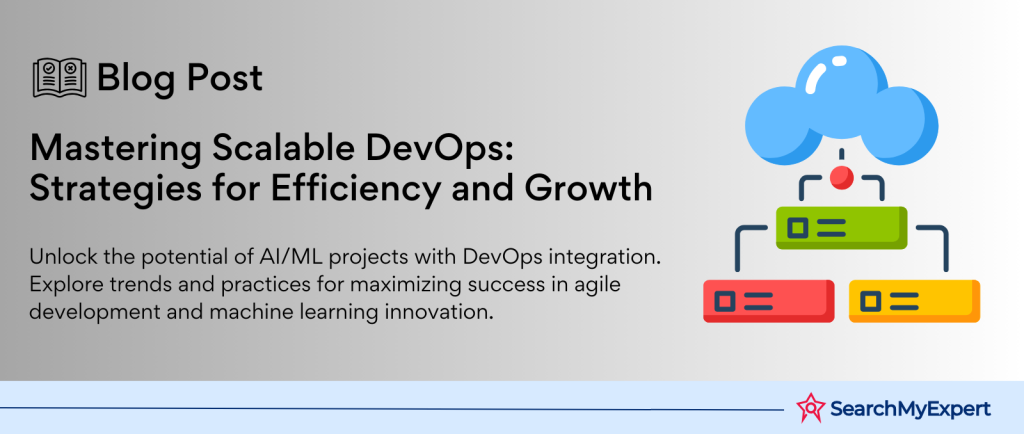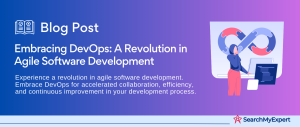Scaling DevOps Practices
Defining Scaling in the Context of DevOps
In the fast-paced world of software development, scaling in the context of DevOps is a pivotal step. It’s about expanding practices efficiently to handle an increased complexity and workload. But it’s not just about adding more tools or processes; it’s an evolutionary step that involves adapting and enhancing existing practices to meet the growing demands of your projects.
Benefits of Scaling DevOps
The journey towards scaling DevOps is laden with perks that can redefine the landscape of your project management and delivery. Here are the key benefits:
- Faster Delivery:
As you scale your DevOps practices, you’ll notice a significant reduction in the time it takes to move from conception to deployment. It’s like putting your delivery process on a fast track. - Improved Reliability:
With more robust processes in place, the reliability of your software development lifecycle skyrockets. This means fewer fires to put out and more stable releases. - Reduced Costs: Efficiency is a byproduct of scaling DevOps. By streamlining processes, you can cut down on unnecessary expenses, thereby reducing the overall costs.
- Increased Agility: Scaling up your DevOps practices equips your team with the agility to respond to market changes swiftly. This agility is a game-changer in today’s dynamic tech environment.
Potential Challenges in Scaling
Scaling DevOps isn’t a walk in the park. It comes with its own set of challenges:
- Cultural Shifts:
One of the biggest hurdles is the need for cultural change within the organization. Embracing a DevOps mindset across all levels can be daunting. - Managing Complexity: As you scale, the complexity of your processes and tools increases. Managing this complexity without compromising efficiency is a delicate balancing act.
- Tool Integration: With scaling, you might introduce new tools into your ecosystem. Ensuring these tools work harmoniously with your existing setup is crucial.
- Resource Allocation: Effective scaling requires a strategic allocation of resources. Overstretching or underutilizing your assets can hinder the scaling process.
In the upcoming sections, we’ll dive deeper into each of these aspects, exploring how to navigate the challenges and harness the full potential of scaling DevOps practices.
Assess Your Current State
Evaluating DevOps Maturity
To scale your DevOps practices, the first step is a thorough self-assessment. Evaluating your current DevOps maturity is crucial. One effective method is using DORA metrics (DevOps Research and Assessment). These metrics offer a clear framework for understanding where you stand. They focus on key performance indicators like deployment frequency, change failure rate, time to restore service, and lead time for changes. By benchmarking your practices against these metrics, you gain valuable insights into your current state.
Identifying Bottlenecks and Improvement Areas
Once you’ve gauged your maturity level, the next step is to identify the bottlenecks in your processes. These could range from slow deployment practices to inefficient collaboration between development and operations teams. Look for areas where delays or errors commonly occur. By pinpointing these areas, you can target your scaling efforts more effectively.
Analyzing Team Structure, Collaboration, and Tool Utilization
A critical aspect often overlooked is the team structure and the level of collaboration between team members. DevOps is as much about people as it is about processes and tools. Analyze how your teams are structured and how well they work together. Is there a clear line of communication? Are responsibilities and roles well-defined?
Additionally, take a close look at your tool utilization. Are the tools you currently use optimized for your processes? Do they integrate well with each other? Tool utilization can often make or break your DevOps practices, especially when scaling.
By addressing these key areas, you’ll lay a solid foundation for scaling your DevOps practices effectively. It’s about understanding where you are, where you need to be, and the gaps in between.
Cultivate a Scalable DevOps Culture
Fostering a Collaborative Environment
The heart of scaling DevOps practices lies in cultivating a culture where collaboration is not just encouraged but ingrained in the fabric of the team’s operations. Here, the Dev and Ops teams, along with other stakeholders, must function as a cohesive unit, blurring the lines that traditionally separate these roles.
Encouraging Shared Ownership
In a scalable DevOps culture, every team member shares ownership and responsibility for the entire value chain. This means breaking down silos and ensuring that everyone is invested in the project’s success, from inception to delivery and beyond. Shared ownership fosters a sense of unity and purpose, driving teams to work more efficiently and effectively.
Promoting Continuous Learning
Another pillar of a scalable DevOps culture is the emphasis on continuous learning. Technology and methodologies in the DevOps world are always evolving. To keep pace with these changes, teams must be open to learning and adopting new technologies and practices. This approach not only keeps your team on the cutting edge but also ensures that your DevOps practices can scale and adapt to future needs.
By focusing on these key aspects, you can create a robust and scalable DevOps culture, capable of handling the evolving demands of software development and deployment.
Automate Everything You Can
Implementing Robust Automation Across the Workflow
In scaling DevOps, one mantra reigns supreme: automate everything you can. Automation is the cornerstone of an efficient, scalable DevOps process. From infrastructure provisioning to testing, deployment, and monitoring, every phase of your development workflow can benefit from automation. By automating these processes, you minimize human error, save time, and ensure consistency across environments and deployments.
Leveraging Infrastructure as Code (IaC)
A key strategy in automation is the use of Infrastructure as Code (IaC) tools. IaC allows you to manage and provision infrastructure through code rather than through manual processes. It’s about treating your servers, databases, networks, and other infrastructure just like application code. Tools like Terraform, Ansible, and AWS CloudFormation enable you to define your infrastructure in a declarative manner, making it easy to create, modify, and distribute infrastructure resources efficiently.
Continuously Evaluating and Optimizing Automation Scripts
Automation isn’t a set-it-and-forget-it process. It requires ongoing evaluation and optimization to ensure efficiency. Regularly reviewing and refining your automation scripts can lead to significant improvements in your DevOps processes. This constant iteration helps in identifying new opportunities for automation, thus further streamlining your workflow.
By focusing on these aspects of automation, you can significantly enhance the scalability and efficiency of your DevOps practices.
Adopt a Continuous Delivery Pipeline
Building a Reliable Continuous Delivery Pipeline
Adopting a Continuous Delivery (CD) pipeline is a critical step in scaling DevOps practices. This pipeline automates the delivery of code changes from the development phase right through to production. The goal is to make deployments predictable, routine affairs that can be performed on demand. This pipeline should encompass everything from code compilation, testing, to deployment, ensuring that each step is seamlessly automated.
Integrating Security Practices: DevSecOps
An essential aspect of a CD pipeline is the integration of security practices – a concept often referred to as DevSecOps. By embedding security checks and protocols throughout the pipeline, you ensure that security is not an afterthought but a fundamental part of the development process. This approach helps in identifying and addressing security issues early, thereby reducing the risk of vulnerabilities in your final product.
Monitoring and Managing Pipeline Performance
Once your CD pipeline is in place, continuous monitoring and management of its performance are crucial. This involves tracking key metrics to identify bottlenecks and inefficiencies. By doing so, you can make informed decisions to improve the stability and efficiency of the pipeline, and also gather valuable feedback for future enhancements.
Implementing and fine-tuning your continuous delivery pipeline is a dynamic, ongoing process that plays a pivotal role in scaling your DevOps practices effectively.
Scale Tools and Infrastructure
Choosing Scalable and Flexible Tools
As you scale your DevOps practices, the choice of tools becomes increasingly critical. Opt for scalable and flexible tools that can comfortably support your organization’s growing needs and the ever-evolving technology landscape. These tools should not only meet your current requirements but also be adaptable to future technologies and methodologies.
Utilizing Cloud Platforms and Containerization
Embrace the power of cloud platforms and containerization technologies for enhanced elasticity and efficiency. Cloud platforms like AWS, Azure, and Google Cloud provide the flexibility to scale resources according to demand, ensuring that you only pay for what you use. Containerization, with technologies like Docker and Kubernetes, offers a lightweight, consistent environment for your applications, simplifying deployments and scaling.
Implementing Infrastructure Monitoring and Alerting
An often overlooked yet vital aspect of scaling your infrastructure is implementing robust monitoring and alerting systems. These systems are crucial for proactive issue identification and resolution. They allow you to monitor the health and performance of your infrastructure in real-time, providing alerts for any anomalies or performance issues. This proactive approach ensures that potential problems are addressed before they escalate, maintaining the stability and reliability of your infrastructure.
By focusing on these areas, you can ensure that your tools and infrastructure not only keep pace with your growing organization but also contribute to the efficiency and effectiveness of your DevOps practices.
Conclusion
In the journey of scaling DevOps practices, continuous measurement and adaptation are key. Defining and monitoring key performance indicators (KPIs) like lead time, deployment frequency, and error rate is essential to gauge progress and identify improvement areas. Regular data analysis allows for fine-tuning practices, ensuring they align with evolving goals and industry standards. This cycle of measurement and refinement is the heartbeat of a scalable, efficient DevOps environment, driving innovation and excellence in software development and deployment.
Revolutionize your software development lifecycle with our DevOps Services.
Table of Contents
Toggle






